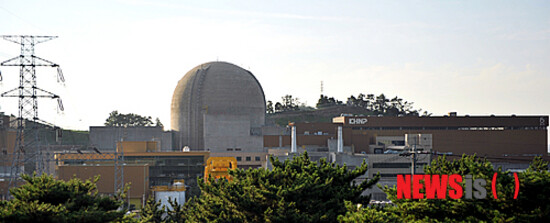hankyoreh
Links to other country sites 다른 나라 사이트 링크
Nuclear reactor shut down for safety reasons

By Noh Hyung-woong, staff reporter
Reactor 6 at Younggwang Nuclear Power Plant in South Jeolla province was shut down again on July 30 due to a malfunctioning reactor rod.
The reactor rod functions as a safety shield for reactors. The basic structure of a reactor can be simplified as follows: heat is produced when neutrons come into contact with uranium, and that heat turns the turbines to generate electricity.
The main challenge of reactor safety is keeping that fission stable. The Chernobyl disaster, the worst nuclear accident in history, occurred because the reactor rods were removed quickly, which stimulated fission.
The repeated problems with Younggwang reactor 6 have residents in the area nervous. Reactor 6 first broke down during a 2002 trial run. Since then, it has gone out of action 9 times in past 10 years.
Among those cases, some were trivial, due to lightning strikes and a mistake on operation. But in Dec. 2008, the reactor was stopped because warning signals appeared, indicating the reactor rod was in the wrong position.
Yang-yi Won-young director of Common Action for Nuke Free Society said, “The reactor rod is the last line of defense against a serious accident. It was fortunate that the reactor was shut down in time. If it hadn‘t been, it would have created a terrible disaster.”
Some brought up the problem of Korean-style pressurized light water reactors, citing their frequent breakdowns. “The reactors that recently broke down, including reactor 6 at the Younggwang plant, are localized as Korean style,” said Professor Suh Kune-yull at the Nuclear Engineering Dept. of Seoul National University. “It seems that their electronic circuits and other components fail frequently.”
A source from Korea Hydro and Nuclear Power (KHNP) said, “If we have a trouble with a reactor rod, we can go straight into fuel cell and stop nuclear fission. For this time, the operation was stopped as planned.” He added, “Furthermore, there are a lot of reactor rods in operation. There’s no doubt about safety.”
KHNP emphasized that this breakdown conformed to standard 0 of accident conditions according to International Atomic Energy Agency (IAEA). They added this accident didn‘t have an effect on the plant’s safety.
On the other hand, the Ministry of Knowledge Economy (MKE) seems puzzled since more and more people raised the questions of the safety of nuclear power plants. In particular, the Younggwang accident happened while MKE has been moving to restart Kori Nuclear reactor No.1.
A source from MKE said, “The residents of Busan are protesting strongly to stop the Kori reactor, but we still need to operate it to satisfy demand for electricity. It is embarrassing that the accident happened at this time.”
He added, “First, we will inspect in order to determine the cause of the accident, and then will restart the reactor. Also, we will continue to persuade the residents of Busan about the safety of operating Kori reactor No.1.”
Translated by Kim Ji-seung, Hankyoreh English intern
Please direct questions or comments to [english@hani.co.kr]

Editorial・opinion
![[Column] Season 2 of special prosecutor probe may be coming to Korea soon [Column] Season 2 of special prosecutor probe may be coming to Korea soon](https://flexible.img.hani.co.kr/flexible/normal/500/300/imgdb/original/2024/0426/3317141030699447.jpg) [Column] Season 2 of special prosecutor probe may be coming to Korea soon
[Column] Season 2 of special prosecutor probe may be coming to Korea soon![[Column] Park Geun-hye déjà vu in Yoon Suk-yeol [Column] Park Geun-hye déjà vu in Yoon Suk-yeol](https://flexible.img.hani.co.kr/flexible/normal/500/300/imgdb/original/2024/0424/651713945113788.jpg) [Column] Park Geun-hye déjà vu in Yoon Suk-yeol
[Column] Park Geun-hye déjà vu in Yoon Suk-yeol- [Editorial] New weight of N. Korea’s nuclear threats makes dialogue all the more urgent
- [Guest essay] The real reason Korea’s new right wants to dub Rhee a founding father
- [Column] ‘Choson’: Is it time we start referring to N. Korea in its own terms?
- [Editorial] Japan’s rewriting of history with Korea has gone too far
- [Column] The president’s questionable capacity for dialogue
- [Column] Are chaebol firms just pizza pies for families to divvy up as they please?
- [Column] Has Korea, too, crossed the Rubicon on China?
- [Correspondent’s column] In Japan’s alliance with US, echoes of its past alliances with UK
Most viewed articles
- 1[Column] Season 2 of special prosecutor probe may be coming to Korea soon
- 2‘We must say no’: Seoul defense chief on Korean, USFK involvement in hypothetical Taiwan crisis
- 3Is N. Korea threatening to test nukes in response to possible new US-led sanctions body?
- 4Division commander ordered troops to enter raging flood waters before Marine died, survivor says
- 5Amnesty notes ‘erosion’ of freedom of expression in Korea in annual human rights report
- 6Is Japan about to snatch control of Line messenger from Korea’s Naver?
- 7No good, very bad game for Korea puts it out of Olympics for first time since 1988
- 8[Editorial] Korea’s surprise Q1 growth requires objective assessment, not blind fanfare
- 9N. Korean delegation’s trip to Iran shows how Pyongyang is leveraging ties with Moscow
- 10Korea’s 1.3% growth in Q1 signals ‘textbook’ return to growth, says government